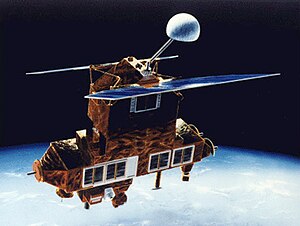Earth Radiation Budget Satellite
| Earth Radiation Budget Satellite | |
|---|---|

|
|
| Type: | Research satellite |
| Country: |
|
| Operator: |
|
| COSPAR-ID : | 1984-108B |
| Mission dates | |
| Dimensions: | 2449 kg |
| Begin: | 5th October 1984 |
| Starting place: | Kennedy Space Center |
| Launcher: | Space Shuttle Challenger |
| Flight duration: | 21 years |
| Status: | Out of service |
| Orbit data | |
| Rotation time : | 96.4 min |
| Orbit inclination : | 56.9 ° |
| Apogee height : | 599 km |
| Perigee height : | 572 km |
| Eccentricity : | 0.00194 |
The Earth Radiation Budget Satellite (ERBS) was a NASA- built research satellite that was launched on October 5, 1984 to measure the radiation intensity of the Earth and the amount of stratospheric aerosol gas.
Mission history
The satellite was launched into low earth orbit by the space shuttle Challenger and was stationed by astronaut Sally Ride during the STS-41-G mission . The satellite initially had a planned lifespan of two years. But it was still sending data about the ozone layer after more than two decades . Finally, for financial reasons, the project ended on October 14, 2005, making ERBS one of the longest space missions of all time.
Experiments carried out
ERBS was one of three satellites in the Earth Radiation Budget Experiment and housed two instruments: the ERBE scanner, three detectors that measured long-wave radiation, short-wave radiation and the full energy of radiation from Earth, and the ERBE non-scanner , 5 detectors that measured all the energy from the sun and shortwave and all the energy from all of the earth and under the area of the satellite. In addition, ERBS transported the Stratospheric Aerosol and Gas Experiment ( SAGE II).
Influence in the Montreal Protocol
The ERBS data on the ozone layer were instrumental in the decision of the international community to ban CFC emissions in developed countries under the Montreal Protocol .
Other satellites in the ERBE project
A second ERBE experiment was started with the NOAA-9 satellite in January 1985 and a third experiment with the NOAA-10 satellite in October 1986.
Web links
- The site of ERBS at NASA (English)
